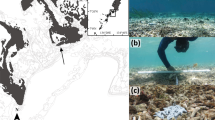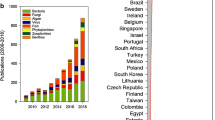Abstract
Identifying and understanding predator diets is of high importance in biological conservation. This is particularly true for the introduction, establishment and maintenance of predator populations in newly created or modified ecological communities, such as translocation sites or restored habitats. Conservation status of predators may not permit captive feeding trials or intrusive gut-content methods, so non-intrusive diet assessment is required, such as faecal analysis. However, prey such as earthworms leave no morphological clues suitable for accurately discriminating between species consumed through visual faecal analysis. This study uses non-intrusive molecular methods on earthworm DNA extracted from the faeces of the carnivorous land snail Powelliphanta patrickensis to identify its earthworm diet and any seasonal trends. Data from 454-pyrosequencing revealed earthworm DNA in all samples (n = 60). Sequences were compared to a DNA library created from published and unpublished studies of New Zealand’s endemic earthworms and online databases. Unidentified earthworm sequences were clustered into molecular operational taxonomic units (MOTUs). Twenty-six MOTUs were identified, 17 of which matched the library, whereas nine did not. Similarity indices indicate that there were seasonal differences (P < 0.05) in the earthworm communities represented in the summer and the winter diets. This study highlights the importance of utilising the vast body of data generated by pyrosequencing to investigate potential temporal diet shifts in protected species. The method described here is widely applicable to a wide range of predatory species of conservation interest and can further inform habitat restoration and relocation programmes to optimize the long-term survival of the target species.




Similar content being viewed by others
References
Abdul-Kareem AW, McRae SG (1984) The effects on topsoil of long-term storage in stockpiles. Plant Soil 76:357–363. doi:10.1007/BF02205593
Altschul S, Gish W, Miller W et al (1990) Basic local alignment search tool. J Mol Biol 215:403–410
Andelman SJ, Fagan WF (2000) Umbrellas and flagships: efficient conservation surrogates or expensive mistakes? Proc Natl Acad Sci USA 97:5954–5959
Bohmann K, Monadjem A, Lehmkuhl Noer C et al (2011) Molecular diet analysis of two African free-tailed bats (Molossidae) using high throughput sequencing. PLoS One 6:e21441. doi:10.1371/journal.pone.0021441
Bouché MB (1972) Lombriciens de France, ecologie et systématique. Ann Zool—Ecol Anim 92:45. doi: 10.3917/ls.092.0045
Boyer S, Wratten SD (2010) Using molecular tools to identify New Zealand endemic earthworms in a mine restoration project. Zool Middle East 51:31–40
Boyer S, Blakemore R, Wratten S (2011a) An integrative taxonomic approach to the identification of three new New Zealand endemic earthworm species (Acanthodrilidae, Octochaetidae: Oligochaeta). Zootaxa 32:21–32
Boyer S, Wratten S, Pizey M, Weber P (2011b) Impact of soil stockpiling and mining rehabilitation on earthworm communities. Pedobiologia 54:S99–S102. doi:10.1016/j.pedobi.2011.09.006
Boyer S, Yeates GW, Wratten SD et al (2011c) Molecular and morphological analyses of faeces to investigate the diet of earthworm predators: example of a carnivorous land snail endemic to New Zealand. Pedobiologia 54:S153–S158. doi:10.1016/j.pedobi.2011.08.002
Boyer S, Wratten SD, Holyoake A et al (2013) Using next-generation sequencing to analyse the diet of a highly endangered land snail (Powelliphanta augusta) feeding on endemic earthworms. PLoS One 8:e75962. doi:10.1371/journal.pone.0075962
Braley M, Goldsworthy SD, Page B et al (2010) Assessing morphological and DNA-based diet analysis techniques in a generalist predator, the arrow squid Nototodarus gouldi. Mol Ecol Resour 10:466–474. doi:10.1111/j.1755-0998.2009.02767.x
Brown DS, Jarman SN, Symondson WOC (2012a) Pyrosequencing of prey DNA in reptile faeces: analysis of earthworm consumption by slow worms. Mol Ecol Resour 12:259–266. doi:10.1111/j.1755-0998.2011.03098.x
Brown SDJ, Collins R, Boyer S et al (2012b) Spider: an R package for the analysis of species identity and evolution, with particular reference to DNA barcoding. Mol Ecol Resour 12:562–565. doi:10.1111/j.1755-0998.2011.03108.x
Buckley H, Damgaard C (2012) Lorenz R: R code for drawing sample Lorenz curves and to calculate Gini coefficients and Lorenz asymmetry coefficients. In: Buckley HL, Damgaard C. http://pure.au.dk/portal/en/publications/lorenzr(21dbe72d-0f9c-4a3b-9a2c-f364828089d3).html
Buckley TR, James S, Allwood J et al (2011) Phylogenetic analysis of New Zealand earthworms (Oligochaeta: Megascolecidae) reveals ancient clades and cryptic taxonomic diversity. Mol Phylogenet Evol 58:85–96. doi:10.1016/j.ympev.2010.09.024
Chaoui HI, Zibilske LM, Ohno T (2003) Effects of earthworm casts and compost on soil microbial activity and plant nutrient availability. Soil Biol Biochem 35:295–302. doi:10.1016/S0038-0717(02)00279-1
Clarke KR, Gorley RN (2006) PRIMER v.6: user manual/tutorial. PRIMER-E, Plymouth
Colbourne R, Powlesland R (1988) Diet of the Stewart Island brown kiwi (Apteryx australis lawryi) at Scollay’s Flat, southern Stewart Island. N Z J Ecol 11:99–104
Damgaard C, Weiner J (2000) Describing inequality in plant size or fecundity. Ecology 81:1139–1142
Deagle BE, Tollit DJ (2006) Quantitative analysis of prey DNA in pinniped faeces: potential to estimate diet composition? Conserv Genet 8:743–747. doi:10.1007/s10592-006-9197-7
Deagle BE, Kirkwood R, Jarman SN (2009) Analysis of Australian fur seal diet by pyrosequencing prey DNA in faeces. Mol Ecol 18:2022–2038. doi:10.1111/j.1365-294X.2009.04158.x
Deagle BE, Chiaradia A, McInnes J, Jarman SN (2010) Pyrosequencing faecal DNA to determine diet of little penguins: is what goes in what comes out? Conserv Genet 11:2039–2048. doi:10.1007/s10592-010-0096-6
Efford M (2000) Consumption of amphipods by the New Zealand land snail Wainuia urnula (Pulmonata: Rhytididae). J Mollusc Stud 66:45–52. doi:10.1093/mollus/66.1.45
Floyd R, Abebe E, Papert A, Blaxter M (2002) Molecular barcodes for soil nematode identification. Mol Ecol 11:839–850
García-Berthou E, Moreno-Amich R (2000) Food of introduced pumpkinseed sunfish: ontogenetic diet shift and seasonal variation. J Fish Biol 57:29–40. doi:10.1006/jfbi.2000.1285
Gardner W, Broersma K, Naeth A (2010) Influence of biosolids and fertilizer amendments on physical, chemical and microbiological properties of copper mine tailings. Can J Soil Sci 90:571–583. doi:10.4141/CJSS09067
Hill D (1997) Seasonal variation in the feeding behavior and diet of Japanese macaques (Macaca fuscata yakui) in lowland forest of Yakushima. Am J Primatol 322:305–322
King RA, Vaughan IP, Bell JR et al (2010) Prey choice by carabid beetles feeding on an earthworm community analysed using species- and lineage-specific PCR primers. Mol Ecol 19:1721–1732. doi:10.1111/j.1365-294X.2010.04602.x
Lake S, Burton H, van den Hoff G (2003) Regional, temporal and fine-scale spatial variation in Weddell seal diet at four coastal locations in east Antarctica. Mar Ecol Prog Ser 254:293–305. doi:10.3354/meps254293
Lindenmayer DB, Manning AD, Smith PL et al (2002) The focal-species approach and landscape restoration: a critique. Conserv Biol 16:338–345
Milcu A, Schumacher J, Scheu S (2006) Earthworms (Lumbricus terrestris) affect plant seedling recruitment and microhabitat heterogeneity. Funct Ecol 20:261–268. doi:10.1111/j.1365-2435.2006.01098.x
Murray DC, Bunce M, Cannell BL et al (2011) DNA-based faecal dietary analysis: a comparison of qPCR and high throughput sequencing approaches. PLoS One 6:e25776. doi:10.1371/journal.pone.0025776
Piearce T (1978) Gut contents of some lumbiricid earthworms. Pedobiologia 18:153–157
Pompanon F, Deagle BE, Symondson WOC et al (2012) Who is eating what: diet assessment using next generation sequencing. Mol Ecol 21:1931–1950. doi:10.1111/j.1365-294X.2011.05403.x
R Development Core Team (2011) R: a language and environment for statistical computing
Razgour O, Clare EL, Zeale MRK et al (2011) High-throughput sequencing offers insight into mechanisms of resource partitioning in cryptic bat species. Ecol Evol 1:556–570. doi:10.1002/ece3.49
Scullion J, Malik A (2000) Earthworm activity affecting organic matter, aggregation and microbial activity in soils restored after opencast mining for coal. Soil Biol Biochem 32:119–126
Silcox M, Teaford M (2002) The diet of worms: an analysis of mole dental microwear. J Mammal 83:804–814
Simberloff D (1998) Flagships, umbrellas, and keystones: is single-species management passé in the landscape era? Biol Conserv 83:247–257
Society for Ecological Restoration (2013) http://www.ser.org/resources/resources-detail-view/ecological-restoration-a-means-of-conserving-biodiversity-and-sustaining-livelihoods. http://www.ser.org/resources/resources-detail-view/ecological-restoration-a-means-of-conserving-biodiversity-and-sustaining-livelihoods
Stehlik LL, Meise CJ (2000) Diet of winter flounder in a New Jersey estuary: ontogenetic change and spatial variation. Estuaries 23:381. doi:10.2307/1353330
Suzuki N, Hoshino K, Murakami K et al (2008) Molecular diet analysis of phyllosoma larvae of the Japanese spiny lobster Panulirus japonicus (Decapoda: Crustacea). Mar Biotechnol 10:49–55. doi:10.1007/s10126-007-9038-9
Symondson WOC (2002) Molecular identification of prey in predator diets. Mol Ecol 11:627–641
Walpole M, Leader-Williams N (2002) Tourism and flagship species in conservation. Biodivers Conserv 11:543–547
Williams PH, Burgess ND, Rahbek C (2000) Flagship species, ecological complementarity and conserving the diversity of mammals and birds in sub-Saharan Africa. Anim Conserv 3:249–260
Acknowledgments
This study was financially supported by The Bio-Protection Research Centre, New Zealand, the Miss E. L. Hellaby Indigenous Grassland Trust, and Solid Energy New Zealand. We thank Paul Weber for advice and MBC Consulting, in particular Mark Hamilton, for mine site access and sampling support. Finally, thanks to the anonymous reviewers whose comments and feedback led to a substantially improved manuscript.
Author information
Authors and Affiliations
Corresponding author
Additional information
Communicated by Nina Farwig.
Rights and permissions
About this article
Cite this article
Waterhouse, B.R., Boyer, S. & Wratten, S.D. Pyrosequencing of prey DNA in faeces of carnivorous land snails to facilitate ecological restoration and relocation programmes. Oecologia 175, 737–746 (2014). https://doi.org/10.1007/s00442-014-2933-7
Received:
Accepted:
Published:
Issue Date:
DOI: https://doi.org/10.1007/s00442-014-2933-7




